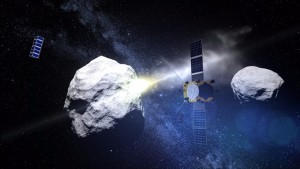The NAOSat platform from the UMH company EMXYS, selected in the study phase for a mission to an asteroid
Campus, Elche, Fuente, Investigación, Noticia, Noticia con foto, Others, Front UMH
16 November 2015
The European Space Agency has selected the NAOSat platform from the company EMXYS, led by Miguel Hernández University of Elche (UMH) faculty José Antonio Carrasco and Francisco Javier García de Quirós, in the Asteroid Geological Explorer project (AGEX) led by the Royal Observatory of Belgium. This company, located at the UMH Scientific and Business Park, is one of the candidates to produce a demonstration payload for the Asteroid Impact Mission (AIM), which, in collaboration with NASA, intends to intercept the Didymos asteroid, divert its trajectory, and learn about the evolution of these bodies over the Solar System’s history.
José Antonio Carrasco and Francisco Javier García de Quirós, from the Materials Science, Optics and Electronic Technology Department, form part of EMXYS, whose nanosatellites have been selected for the study of their placement in orbit around an asteroid onboard a European Space Agency spacecraft. This project aims to study the material on the asteroid’s surface, its gravity, internal structure, and also deploy a network of chipsats that float around it and on its surface.
The mission’s main purpose is scientific and intends to study the geological properties of the Didymos double asteroid. Likewise, NASA will crash a spacecraft into the asteroid to study the possibilities of modifying its orbit with the objective of protecting Earth from asteroid impacts that could endanger the planet.
The Asteroid Impact Mission of the European Space Agency is a joint initiative with NASA to investigate the composition and physical properties of Near Earth Objects in order to protect the planet from future collisions by diverting asteroids that may pose a danger from impact. The Double Asteroid Redirection Test to be carried out by NASA intends to impact the companion asteroid of Didymos at a high velocity, with the objective of modifying its orbit.
Near Earth asteroids are of interest due to the potential danger of colliding with the planet in the medium term. Some collisions have occurred in the past, like the case of the Tunguska event in Siberia 107 years ago, or that which is thought to have produced the extinction of the dinosaurs some 65 million years ago. Although large catastrophic events are rare, small asteroids, such as the one that fell on Chelyabinsk (Russia) on February 15, 2013 are not unusual, and can cause considerable damage to people and property.
The Asteroid Geological Explorer mission (AGEX) is led by the Royal Observatory of Belgium, and in it participate the Higher Institute of Aeronautics and Space (France), Antwerp Space (Belgium), Asteroid Initiatives LLC (USA), and EMXYS.
EMXYS is an innovative company that, from the UMH Scientific and Business Park, designs, develops, and produces embedded instruments, data acquisition, and control systems for space applications with the capacity to provide products and services in R&D. The NAOSat prototype is a modular nanosatellite architecture for scientific and technological demonstrations that provides a standard platform to easily accommodate a number of payloads in several bays connected to the platform by a single bus.
The European Space Agency is an international organization comprised of 22 member states. By coordinating the financial and intellectual resources of its members, it can carry out joint activities related to space that go far beyond the capabilities of any single member.




